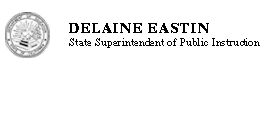Attendance Accounting for On-Line Classes


Official Letter
Official Letter
April 24, 2001
To: County and District Superintendent
Attention: County and District Chief Business Officers and Directors of Curriculum
From: Janet Sterling, Director, School Fiscal Services Division
Subject: Attendance Accounting for On-Line Classes
Teachers need a wide variety of options to develop a curriculum that appeals to students while expanding their knowledge, increasing their competencies, and simultaneously meeting traditional goals. Recent advancements in technology present exciting opportunities for innovative curriculum as well as new instructional mediums. Furthermore, the use of technology provides an alternative for districts that might not otherwise have the resources to provide coursework in specific subject areas.
In recent months, the California Department of Education (CDE) has received numerous questions regarding the use of on-line curriculum, including the eligibility of on-line programs for apportionment credit. This letter summarizes CDE's understanding of the instructional settings in which on-line classes may be provided, as well as details the attendance accounting requirements thereof.
On-line curriculum may be presented either in a classroom setting or through independent study. The appropriate method of attendance accounting for such classes is dependent upon the instructional setting utilized, not on the curriculum itself.
Subdivision (a) of Education Code Section 46300 provides, in part:
"In computing average daily attendance of a school district or county office of education, there shall be included the attendance of pupils while engaged in educational activities required of those pupils under the immediate supervision and control of an employee of the district or county office who possessed a valid certification document, registered as required by law."
Many schools provide an on-line curriculum in a classroom setting similar to all other class periods, except that, in some instances, the certificated employee acts as a "tutor" or "facilitator," rather than as an "instructor." In this setting, a daily "period" attendance form identical to that used in the other class periods is the appropriate attendance accounting document.
Independent study is an alternative instructional strategy that may also be utilized to implement instruction through an on-line course. It is important to note that Education Code sections 51747, et seq. provide that the apportionment credit for independent study is made on the basis of the student's "product" (study or academic work), assessed by a competent, certificated employee of the district.
Districts that opt to use the independent study strategy are advised
to familiarize themselves with the requirements for independent
study. These requirements are complex and district compliance is
rigorously audited in the annual audit required pursuant to Education
Code Section 41020. Additional information on requirements
for independent study can be found at http://www.cde.ca.gov/spbranch/essdiv/is_index.html
[Note, the preceding Web address is no longer valid and has been replaced by http://www.cde.ca.gov/sp/eo/is/index.asp] or by calling the Educational Options Office at 916-322-5012.
Copies of the Independent Study Operations Manual (2000 Edition)
may be purchased from the CDE Press (found in its catalog,
Educational Resources 2001, page 22, Item No. 1500). Copies can
also be ordered by telephoning 1-800-995-4009, or by submitting
a district purchase order via FAX to 916-323-0823.
It may be that individual students' programs consist of part classroom-based study and part independent study. Education Code sections 46110 and 46140 limit elementary and most secondary students to one day of apportionment credit in any calendar day. District procedures must prevent the claiming of any combination of classroom and independent study credits that would exceed one day of apportionment credit per day of instruction in the school's calendar. In addition, if the student is scheduled for at least the minimum day (in most instances, 240 minutes) of classroom-based study, or is assigned at least the minimum day's worth of instruction through independent study, then the attendance accounting for apportionment purposes can be determined solely from that predominant instructional setting.
The advent of new technologies presents fascinating opportunities
for students to learn. When properly accounted for, the instructional
time for on-line courses may be used in the calculations of instructional
minutes and minimum day attendance. For further information or clarification
regarding attendance accounting or other apportionment-related issues
for on-line classes, please contact the School Fiscal Services Division,
Fiscal Policy Office, at (916) 323-8068 [Note, the preceding unit is no longer valid and has been replaced by Office of Principal Apportionment and Special Education at 916-324-4541].
